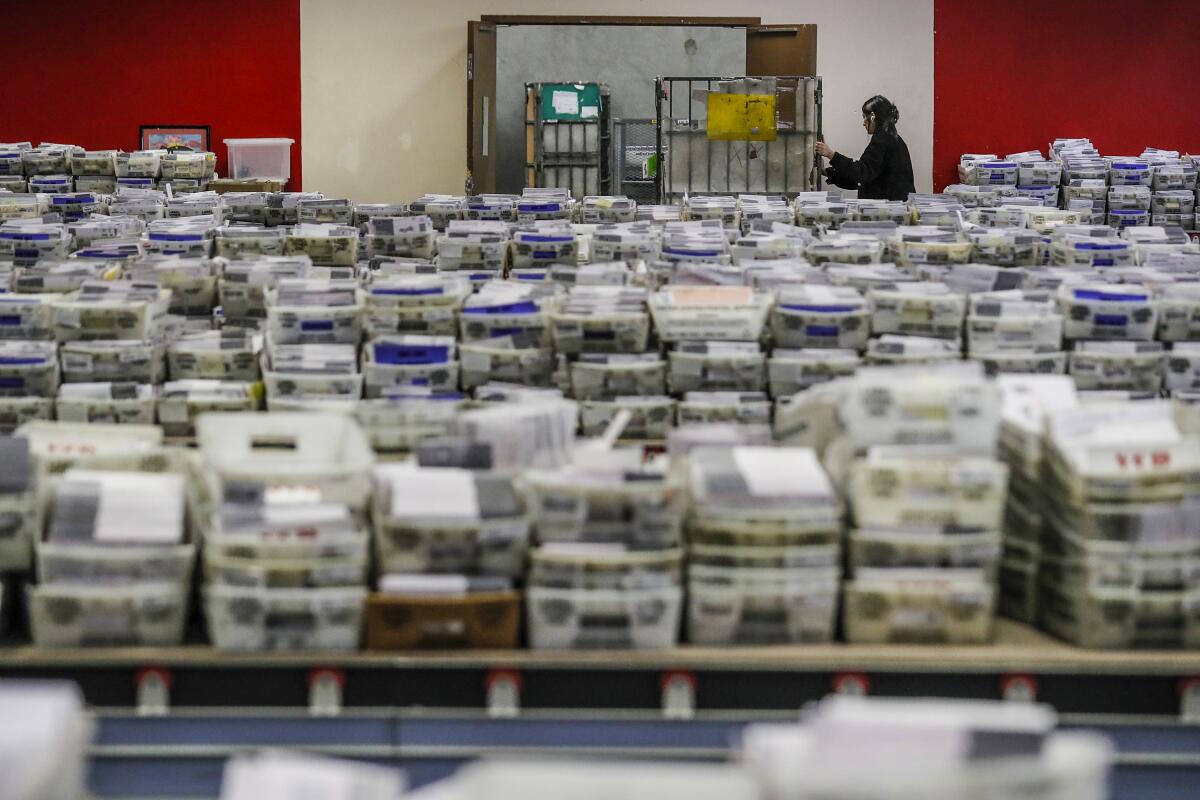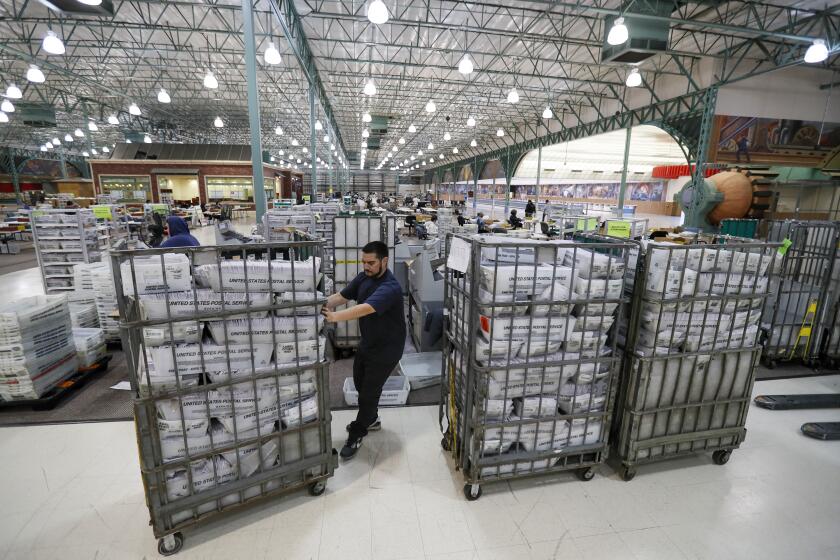When will we know who won the L.A. mayoral race â and why is it taking so long?

More than 680,000 votes have been counted in the race for mayor of Los Angeles between Rep. Karen Bass and Rick Caruso. While Bass has the lead, thereâs no final call on who won the race. Whatâs going on, why does it take so long, and how come we donât yet know who won?
What does it mean when news organizations âcallâ a race?
Officially, nothing. Regardless of what we say, election workers keep on counting ballots until every one has been tallied, and candidates donât become elected officials until the returns are certified. Once itâs no longer mathematically possible for the trailing candidate to overtake the leader, however, thereâs no reason to keep people in suspense awaiting the final, official count. At that point, news organizations will call a race.
Donât news organizations sometimes call races before the outcome is a mathematical certainty?
Yes, if thereâs an exit poll of the race, and the vote count and the exit poll are telling the same story about how the race is going, news organizations can sometimes call a race once the outcome seems all but irreversible.
Is there an exit poll in the L.A. mayorâs race?
No.
So what does the math look like?
As of Mondayâs count, which is the most recent, Bass had 354,948 votes, or 52.15%, and Caruso had 325,677, or 47.85%. Thatâs a lead for her of 29,271 votes.
How many votes are left to count?
No one knows.
Huh? How can that be?
Under California law, elections officials must accept ballots that are postmarked by election day if they are received up until one week after the election. That means there could be more ballots in the mail that the Los Angeles County registrar hasnât received yet. Thereâs no way to know how many may still be received by the close of business on Tuesday. Itâs probably not a huge number â generally, most ballots arrive within a few days â but no one knows for sure.
L.A. County generally releases new vote totals only twice a week. That allows for more substantial updates, rather than incremental ones âwhere things are bouncing back and forth,â the countyâs top voting official said.
How many uncounted ballots does the registrar currently have?
Thatâs also unknown. The registrar doesnât separate out ballots by city until they are counted, so all that officials know for sure is how many ballots are uncounted countywide.
Mondayâs count included about 75,000 new ballots. As of Monday, the registrar-recorderâs office estimated that number at 655,300. Of those, the vast majority are vote-by-mail ballots. About 15,000 are unprocessed conditional voter registration ballots, and several hundred are provisional ballots.
âWe are working as quickly as we can around the clock, so if we can get more in there, know thatâs the goal,â Mike Sanchez, the county registrar-recorder spokesperson, said Monday morning. Another count update is scheduled for Tuesday afternoon.
Whatâs the trend in the count so far?
On Wednesday morning after election day, Caruso was ahead, 50.3% to 49.6% (212,430 votes to 209,621 votes). By midnight on Thursday night, another 123,136 votes had been counted, and Carusoâs lead had shrunk slightly to 50.2% to 49.7% (273,941 votes to 271,246 votes). On Friday, the registrarâs office released the tally of an additional 29,993 votes, and Bass took the lead, 50.38% to 49.62% (289,782 to 285,398). Then on Saturday, the registrar released the count of another 29,337 votes, which widened Bassâ lead to where it currently stands.
Is it normal for the leader to shift that way?
Yes, a very similar shift took place in the June primary, in which Bass went from 5 points behind Caruso on election night to 7 points ahead once all the votes were counted.
Why does that happen?
In Los Angeles, the voters who wait until close to the last minute to put their ballots into the mail or drop boxes tend to be young people, and they tend to be liberal. Conservative voters have shown a strong preference for voting in person on election day. So Caruso, who was the more conservative candidate, did very well with election day voters, but Bass has gained strength as more late-arriving ballots have been counted.
Is that true everywhere?
No. In Riverside County, for example, the vote count in the very close contest for the 41st Congressional District has shifted toward the Republican incumbent, Rep. Ken Calvert, as more late-arriving ballots have been tallied.
Are these sorts of long counts a new thing?
No, not really. Back in 2010, for example, when Kamala Harris, then the district attorney in San Francisco, ran against Los Angeles County Dist. Atty. Steve Cooley for the post of state attorney general, the race wasnât called until Nov. 25.
Why does it take so long to count the mail-in ballots?
Election workers have to look at each ballot envelope and verify that the signature matches the one on file before the ballot can be opened and fed into a counting machine. Ballots that arrive before election day can be processed ahead of time, but late-arriving ballots have to be processed as they arrive.
Is that unique to California?
No. Lots of states are still counting ballots. In New Hampshire, no one knows yet which party will control the state Legislature. Same goes for Pennsylvaniaâs state House. And there are undecided congressional races still in New York, Oregon and Arizona, in addition to several in California. Many other states also have undecided races, but they donât get much attention because they donât affect the overall partisan balance.
But California does seem to take longer, doesnât it?
Yes. The fact that the state allows a week for ballots to arrive lengthens the counting period. Some states set a much earlier deadline, but California wants to ensure that every vote is counted, even if the count is slow. In addition, a large majority of the stateâs voters now cast ballots by mail or drop box, that also makes the count slower.
More to Read
Get the L.A. Times Politics newsletter
Deeply reported insights into legislation, politics and policy from Sacramento, Washington and beyond. In your inbox three times per week.
You may occasionally receive promotional content from the Los Angeles Times.






![[20060326 (LA/A20) -- STATING THE CASE: Marchers organized by unions, religious organizations and immigrants rights groups carry signs and chant in downtown L.A. "People are really upset that all the work they do, everything that they give to this nation, is ignored," said Angelica Salas of the Coalition of Humane Immigrant Rights. -- PHOTOGRAPHER: Photographs by Gina Ferazzi The Los Angeles Times] *** [Ferazzi, Gina -- - 109170.ME.0325.rights.12.GMF- Gina Ferazzi/Los Angeles Times - Thousands of protesters march to city hall in downtown Los Angeles Saturday, March 25, 2006. They are protesting against House-passed HR 4437, an anti-immigration bill that opponents say will criminalize millions of immigrant families and anyone who comes into contact with them.]](https://ca-times.brightspotcdn.com/dims4/default/34f403d/2147483647/strip/true/crop/1983x1322+109+0/resize/840x560!/quality/75/?url=https%3A%2F%2Fcalifornia-times-brightspot.s3.amazonaws.com%2Fzbk%2Fdamlat_images%2FLA%2FLA_PHOTO_ARCHIVE%2FSDOCS%2854%29%2Fkx3lslnc.JPG)






